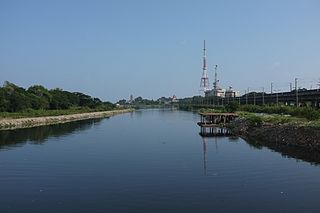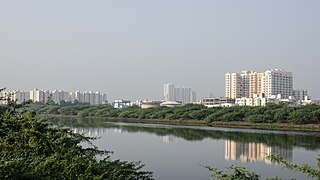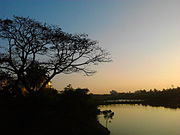
Adyar is a large neighbourhood in south Chennai, Tamil Nadu, India. It is among the most upscale neighborhoods in Chennai.

The Buckingham Canal is a 796 kilometres (494.6 mi)-long fresh water navigation canal, that parallels the Coromandel Coast of South India from Kakinada of Andhra Pradesh to Parangipettai near Chidambaram of Tamil Nadu. The canal connects most of the natural backwaters along the coast to Chennai (Madras) port.

Pulicat Lake is the second largest brackish water lagoon in India,, measuring 759 square kilometres (293 sq mi). A major part of the lagoon lies in the Tirupati district of Andhra Pradesh. The lagoon is one of three important wetlands that attracts northeast monsoon rain clouds during the October to December season. The lagoon comprises the following regions: Pulicat Lake, Marshy/Wetland Land Region (AP), Venadu Reserve Forest (AP), and Pernadu Reserve Forest (AP). The lagoon was cut across in the middle by the Sriharikota Link Road, which divided the water body into lagoon and marshy land. The lagoon encompasses the Pulicat Lake Bird Sanctuary. The barrier island of Sriharikota separates the lagoon from the Bay of Bengal and is home to the Indian Space Research Organisation's Satish Dhawan Space Centre.

The Cooum River, or simply Koovam, is one of the shortest classified rivers draining into the Bay of Bengal. This river is about 72 km (45 mi) in length, flowing 32 km (20 mi) in the city of Chennai and the rest in rural part. The river is highly polluted in the urban area (Chennai). Along with the Adyar River running parallel to the south and the Kosasthalaiyar River, the river trifurcates the city of Chennai and separates Northern Chennai from Central Chennai. It is also sometimes known as Thiruvallikenni river
The flora and fauna of Chennai are the plants and animals in Chennai, India.

Sholinganallur, also spelled Solinganalloor or Sozhinganalloor, is a southern suburb of Chennai, India.
Adyar or Adayar may refer to:

Ennore, also spelt Eṇṇūr, is a neighbourhood in Chennai, India. Ennore is situated on a peninsula and is bounded by the Korttalaiyar River, Ennore Creek and the Bay of Bengal. The creek separates south Ennore from the north Ennore which covers major portions of North Chennai Thermal Power Station and Ennore Port. The neighbourhood is served by Ennore railway station. Over the years Ennore has become the hub of a range of industrial projects, mainly thermal power stations, fertilizer factories, industrial ports and coal yards.

Pichavaram is one of the villages of Parangipettai near Chidambaram in Cuddalore District, Tamil Nadu, India. It is located between the Vellar estuary in the north and Coleroon estuary in the south. The Vellar-Coleroon estuarine complex forms the Killai backwater and the mangroves that are permanently rooted in a few feet of water. It is located at a distance of 243 km from Chennai and 15 km from Chidambaram.
Chennai High Speed Circular Transportation Corridors (HSCTC) is an urban road transit in the form of elevated concentric beltways planned for the city of Chennai. The beltways are envisaged as an elevated 2-tier system with design speed of 80 km/h. The top tier is a 2-lane dedicated corridor for the Chennai BRTS system. The second tier is a 4-lane road for 4-wheelers (no buses and autos).

The Adyar River, which originates near the Chembarambakkam Lake in the Kanchipuram district, is one of the three rivers that winds through Chennai, Tamil Nadu, India, and joins the Bay of Bengal at the Adyar estuary. The 42.5-kilometre (26.4 mi) long river contributes to the estuarine ecosystem of Chennai. Despite the high pollution levels, boating and fishing take place in this river. The river collects surplus water from about 200 tanks and lakes, small streams and the rainwater drains in the city, with a combined catchment area of 860 square kilometres (331 sq mi). Most of the waste from the city is drained into this river and the Cooum.

Semmozhi Poonga, variously spelled as Semmoli Poonga, is a botanical garden in Chennai set up jointly by the Horticulture and Agricultural Engineering department of the Government of Tamil Nadu. The garden was opened on 24 November 2010 by then chief Minister M. Karunanidhi and is the first botanical garden in the city. The garden is located in the Cathedral Road–Anna Salai junction, opposite the American Consulate, on the erstwhile Drive-in Woodlands Hotel. Encompassing an area of 20 acres, it was built at a cost of ₹ 80 million. More than 500 species of plants are being grown in the area, in addition to the 80 trees that were already in existence during the development of the park, some of them being more than 100 years old. The garden houses some of the popular exotic flora and rare plant species, medicinal and aromatic herbs. Many of the exotic plants are imported from countries like China and Thailand, including a plethora of bonsai varieties of ficus microcarpa and ficus ginseng.

Housing more than 200 resident and wintering bird species, Chennai has long been a haven for bird watchers. It is one of the few urban areas in India with diverse range of birds including greater flamingo, black baza, osprey, Indian eagle-owl, Coppersmith barbet, Spot billed pelican and pied avocet can be seen. The following are some known birding hotspots in and around Chennai.

Pallikaranai Marsh is a freshwater marsh in the city of Chennai, India. It is situated adjacent to the Bay of Bengal, about 20 kilometres (12 mi) south of the city centre, and has a geographical area of 80 square kilometres (31 sq mi). Pallikaranai marshland is the only surviving wetland ecosystem of the city and is among the few and last remaining natural wetlands of South India. It is one of the 94 identified wetlands under National Wetland Conservation and Management Programme (NWCMP) operationalised by the Government of India in 1985–86 and one of the three in the state of Tamil Nadu, the other two being Point Calimere and Kazhuveli. It is also one of the prioritised wetlands of Tamil Nadu. The topography of the marsh is such that it always retains some storage, thus forming an aquatic ecosystem. A project on 'Inland Wetlands of India' commissioned by the Ministry of Environment and Forests, Government of India had prioritised Pallikaranai marsh as one of the most significant wetlands of the country. The marsh contains several rare or endangered and threatened species and acts as a forage and breeding ground for thousands of migratory birds from various places within and outside the country. The number of bird species sighted in the wetland is significantly higher than the number at Vedanthangal Bird Sanctuary.
Ennore Creek is a backwater located in Ennore, Chennai along the Coromandel Coast of the Bay of Bengal. It is located in the zone comprising lagoons with salt marshes and backwaters, submerged under water during high tide and forming an arm of the sea with the opening to the Bay of Bengal at the creek. The zone is spread over 4 km2, and the creek covers an area of 2.25 km2. It is located 20 km north of the city centre and 2.6 km south of the Ennore Port; the creek area stretches 3 km into the sea and 5 km along the coast. The creek is nearly 400 m wide, elongated in northeast–southwest direction and merges with the backwater bodies. Once a flourishing mangrove swamp, the creek has been degraded to patches in the fringes mainly due to human activities in the region. The depth of the creek varies between 1 and 2 m and is shallow near the mouth. The north–south trending channels of the creek connect it with the Pulicat Lake to the north and with the distributaries of the Kosasthalaiyar River in the south. The northwestern part of the creek merges with the tidal flats. The soil in the region is loamy and alluvial. Most of the area consists of tracts of alluvial soil and the eastern region comprises beach dunes, tidal flats and creek. The creek is oriented from west to east and opens into the Bay of Bengal to the east at Ennore. The creek acts as an outlet for the excess water from the Poondi reservoir. The creek separates the town of Ennore from the Ennore Port located in the north and the Kattupalli Shipyard located further north. The North Chennai Thermal Power Station is located to the north of the creek and the Ennore Thermal Power Station is located to the south. The creek is part of the Pulicat water system, including the Pulicat lagoon and the Buckingham Canal. As per the 1991 Coastal Regulation Zone notification, the entire Pulicat water system is designated CRZ I. The creek is experiencing siltation due to emergence of the Ennore Port.

Chetpet Lake is a lake spread over 16 acres in Chetpet, Chennai, India. It is located to the north of Chetpet railway station. It is the only existing lake at the centre of the city. The lake belongs to the Department of Fisheries of the Tamil Nadu government.
As of 2019, there are 632 parks in Chennai City, including 142 parks in the north zone, 224 in the central zone, and 266 in the south zone. They range in size from 700 square metres to 5,000 square metres. A couple of the parks, including the Anna Nagar Tower Park, are spread across acres. In 2018, the city's green cover was estimated to be 14.9 percent, up from an estimated 4.5 percent in 2011. The per capita green cover of the city has been estimated at 8.5 square meters, as against the World Health Organization recommendation of 9 square meters of green cover per capita in cities. The city lost around 100,000 trees in December 2016 because of Cyclone Vardah. As of 2018, the city's tree cover is estimated to be around 64.06 sq km. This is just over 15 percent of the entire city. The most dominant species of trees in the city are copper pod, Indian beech, neem, gulmohar, raintree, and tropical almond. The overall extent of open space in the city is 34.58 km2. In all, the city has 121 species of trees belonging to 94 genera and 42 families. Teynampet zone remains the most diverse with 68 species, and Manali zone with just 38 species is the least. With 51 parks, Adyar remains the zone with the highest number of parks in the city, and Tiruvottiyur zone scores the least with only 4 parks. The share of Chennai's greenspace is dominated by the Guindy National Park, with an area of 2.71 sq km, which covers a vast area south of the Adyar River.

Vanashakti is a non-profit environmental NGO based in Mumbai, Maharashtra. It was formed in 2006, by Meenakshi Menon, Namita Roy Ghose, and Peter Armand Menon. Vanashakti aims to conserve the forests, wetlands, wildlife corridors, habitats, through education and litigation to achieve its objectives of creating awareness about environmental topics, protecting and reviving rivers and preventing opencast mining in areas that are well-endowed with biodiversity. It also directs its efforts in involving local forest-dwelling communities to protect the biodiversity of the region and provides sustainable livelihood options for forest dependent and coastal communities. Vanashakti's thrust areas are forest, mangrove and wetland protection, environmental education for both urban and rural schools, livelihoods for forest based communities and scientific investigation into local environmental degradation.

Adyar Creek is a backwater estuary located in Adyar, Chennai at the mouth of the Adyar River along the Coromandel Coast of the Bay of Bengal. The creek begins near the Chetinnad Palace, extending northward into the mainland and taking a complete U-turn near the Foreshore Estate before ending near Mandavelipakkam. The creek surrounds the Quibble Island.

































